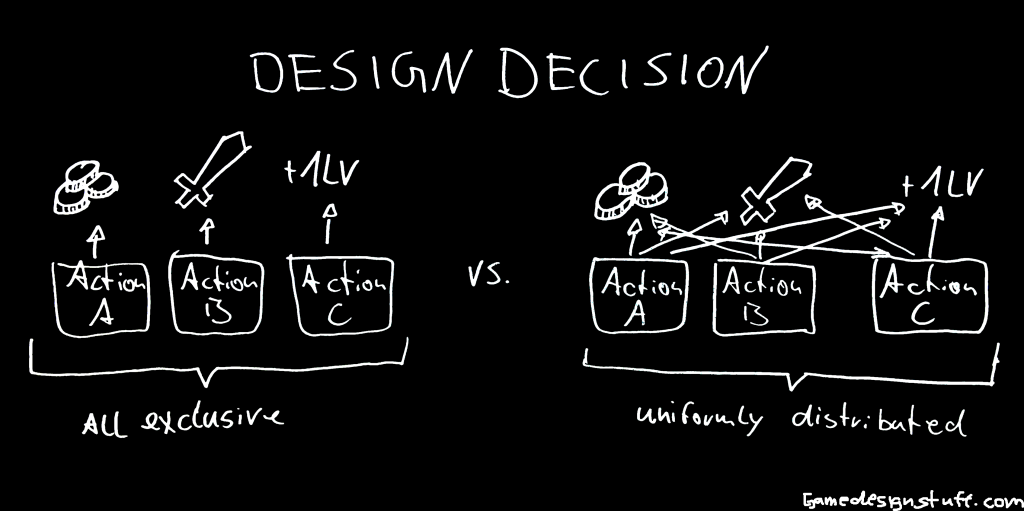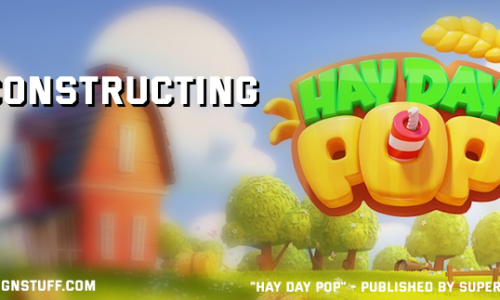Rewards are at the heart of games. They come in many flavors.
When balancing economic rewards such as Currencies, XP, Items and other quantifiable things, we often face a challenge like: “Where do we give the player what?” And “How Much of what?”
This article discusses how giving fewer rewards is more desirable for making a game’s economy tighter and the game more enjoyable for players.

So what does it mean? As the balancer, we have 2 Axises to balance our rewards
What does that mean???
 Again I would like to emphasize that there are tons of other factors that make players enjoy a game. Rewards are just one (important) element. Players will have preferences for mechanics/systems based on many factors (which we only have partial control over). What we do have control over, is the rewards balancing. So let’s continue with that.
The point is: Know your players, decide what kind of decisions you want them to make, and then adjust the reward balancing to that. None of the approaches are perse bad. But we should make it a choice in the design rather than just letting it happen. These small decisions heavily influence how player experience the game and informs their decisions. As designers, we have to use every opportunity to shape that experience.
Again I would like to emphasize that there are tons of other factors that make players enjoy a game. Rewards are just one (important) element. Players will have preferences for mechanics/systems based on many factors (which we only have partial control over). What we do have control over, is the rewards balancing. So let’s continue with that.
The point is: Know your players, decide what kind of decisions you want them to make, and then adjust the reward balancing to that. None of the approaches are perse bad. But we should make it a choice in the design rather than just letting it happen. These small decisions heavily influence how player experience the game and informs their decisions. As designers, we have to use every opportunity to shape that experience.
What does that mean???
Argument 1: The Presenters Paradox
A study shows that adding less desirable information to more desirable information actually diminishes the total value of all the information that are presented. The same is true for items with a quantifiable monetary value (see study 1 in the paper). The problem is that the evaluator of a “bundle” (multiple items) subconsciously averages the value of the all the items. Mixing something very valuable with something that is less valuable will reduce the value of the higher valued item. Hence, when both are combined, the sum is lower. The perceived value is lower than the sum of its parts. If your bundle aims at conversion, this might not be your biggest concern. But if the “bundle” is a set of rewards that players receive, then you probably create a lower motivation to pursue that reward by adding more items to the rewards. Less, in this case, is more. From the study“They could either bundle an iPod Touch MP3 player with 8MB of memory with a cover or the same iPod Touch MP3 player with 8MB of memory with a cover and one free music download. […] They were willing to pay more for the smaller package that contained only the iPod (Mean: $242.19) than for the larger and economically more valuable package that contained the same iPod plus a free music download (Mean: $176.71)“

So what does it mean? As the balancer, we have 2 Axises to balance our rewards
- Type (What do we give?)
- Amount (How much do we give?)
- When your economy has multiple resources and systems: Giving out high valuable items together with lower value items, makes it less special!
- This is something you should strongly consider when you are in charge of designing bundles/prices for items in shops of free to play games! The perceived value of the bundle will be lower than the combined value of the individual items.
Argument 2: Exclusive Rewards Guide Player Behavior
Rewards can be a tool to reinforcing or incentivizing a certain behavior. By receiving a reward, players know they have done something “right”. That they have reached a desirable game state. Players, of course, come with a certain intrinsic motivation and don’t play the game for rewards. Yet, players expect to get something back from the game when they have achieved something or made a choice. Explicit rewards can also motivate the player to engage in an activity that they otherwise not have e.g. Achievements.What does that mean???
- Consider what reward types in your game should be exclusively tied to one activity
- Ask yourself what rewards should the player receive for which activity and why
- Exclusive rewards motivate players to dig into a certain system or practice a certain skill or to play the game in a special way
- An exclusive reward tied to a performance goal can create a high sense of achievement
- If possible, give players the opportunity to revisit their exclusive rewards. Players can relive the memories of their journey towards that reward (items, cutscenes, achievements)

Argument 3: Choices
So we know that giving out multiple things for one activity can have a diminishing effect. Also, we know that we can incentivize player behavior with certain rewards. This means we introduce a choice. That’s cool. But as the designers, we must carefully adjust our reward-sources to meet the sweet spot between “exclusivity” and “uniformly distributed” rewards. Uniformly distributed means that you multiple reward-types from every system in the game. This means that players actions or choices come at a lower opportunity cost since they get more of the different types of rewards from any action. On the other hand, this reduces the sense of choice. Again I would like to emphasize that there are tons of other factors that make players enjoy a game. Rewards are just one (important) element. Players will have preferences for mechanics/systems based on many factors (which we only have partial control over). What we do have control over, is the rewards balancing. So let’s continue with that.
The point is: Know your players, decide what kind of decisions you want them to make, and then adjust the reward balancing to that. None of the approaches are perse bad. But we should make it a choice in the design rather than just letting it happen. These small decisions heavily influence how player experience the game and informs their decisions. As designers, we have to use every opportunity to shape that experience.
Again I would like to emphasize that there are tons of other factors that make players enjoy a game. Rewards are just one (important) element. Players will have preferences for mechanics/systems based on many factors (which we only have partial control over). What we do have control over, is the rewards balancing. So let’s continue with that.
The point is: Know your players, decide what kind of decisions you want them to make, and then adjust the reward balancing to that. None of the approaches are perse bad. But we should make it a choice in the design rather than just letting it happen. These small decisions heavily influence how player experience the game and informs their decisions. As designers, we have to use every opportunity to shape that experience.
What does that mean???
- Opportunity costs and resource scarcity drive players decisions, so by reduction of rewards/opportunities, you end up with a higher player agency. Less is more.
- Carefully adjust the rewards of your game through the lens of players choices
- What systems are part of the core loop, which rewards belong to these systems and which ones not?
- Analyze sources sinks, and try to assign the sources only to those systems where you need them.
- By deciding what players receive for what activity, you also inform their mental model of how the game works
Argument 4: It is easier to understand
Argument 2+3 lead to players having an easier time of building a mental model of the game’s economy or system. When it is clear what choice yields what reward, the players can grasp more easily the systems intentions.- Reduce noise to help players understand what really matters and what they should do








